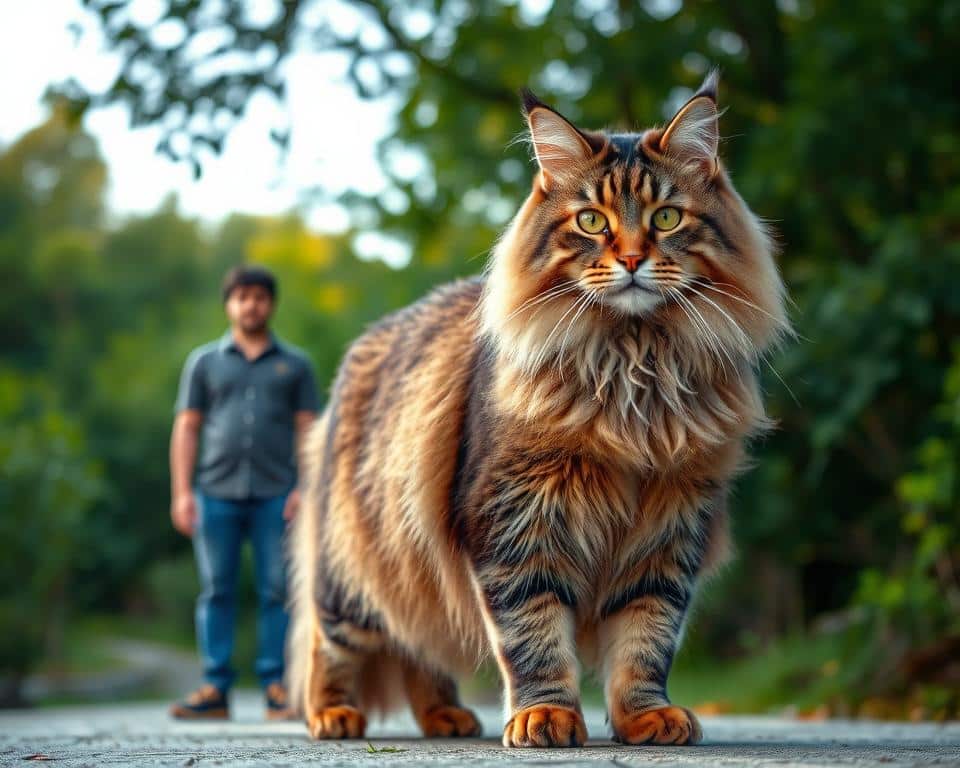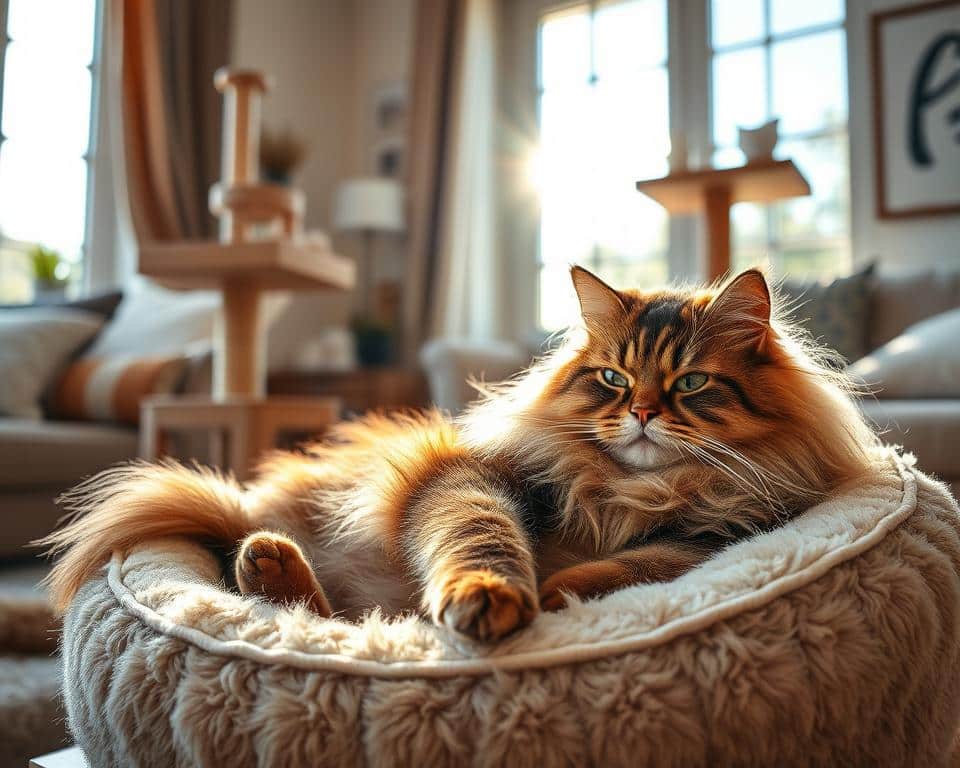Maine Coon cats are truly impressive, with their large size catching many by surprise. They are among the biggest domestic cats, weighing up to 22 pounds. Their muscular and heavy-boned bodies make them a stunning sight.
Originating from the northeastern United States, Maine Coons have adapted to harsh climates. Their thick, water-repellent fur helps them stay warm in cold winters. This fur is a key part of their survival strategy.
Their size is a result of natural selection over time. Bigger cats were more likely to survive and reproduce. This has led to the Maine Coon’s impressive size and strength.
Let’s explore why Maine Coon cats are so big. We’ll see how they became the gentle giants of the cat world.
Key Takeaways
- Maine Coon cats are among the largest domestic cats due to natural adaptations for survival.
- Their robust size is an evolutionary trait developed to navigate and endure cold climates.
- Maine Coon size is also a result of selective natural processes favoring larger individuals within the breed.
- Muscular and heavy-boned structures are characteristic of Maine Coons and contribute to their impressive stature.
- These cats’ thick, water-resistant fur illustrates another aspect of their physical adaptation to their original harsh environments.
- Understanding the Maine Coon’s size provides insight into their historical roles and breeding lineage.
Understanding the Maine Coon Breed
The Maine Coon history and breed origins are quite interesting. They are one of the oldest natural breeds in North America. Known for their Maine Coon appearance, they are called gentle giants. These dog-like cats have traits that many cat lovers find fascinating.
Historical Origins and Evolution
The Maine Coon’s history goes back to the 19th century in the United States, especially in Maine. They became important in local life because of their hunting skills and strong nature. Their origins are often debated, with some thinking they came from Norse explorers and others from North America’s rugged landscapes.
Through natural selection, they developed traits that helped them survive in cold, harsh environments. This shows they evolved naturally, not through myths or crossbreeding.
Characteristics That Define the Breed
Maine Coons are known for their size, bushy tails, and tufted ears. They have a strong, muscular body and a water-resistant coat. This makes them the iconic gentle giants of the cat world.
They are often called dog-like cats because of their sociability and loyalty. Their coats come in many colors and patterns, but the brown tabby is the most common.
Natural Adaptations to Harsh Climates
To survive Maine’s harsh winters, Maine Coons have developed special features. Their thick, water-resistant fur and large, tufted paws help them move in snow. Their long, bushy tails also keep them warm in cold weather.
These adaptations show how they can survive and even thrive in tough climates. It’s a testament to the power of natural selection.
- Maine Coon history: Deeply rooted in American culture
- Breed origins: Evolved in Maine, USA
- Natural breeds in North America: Among the oldest recognized
- Maine Coon appearance: Large, rugged, and shaggy
- Gentle giants: Known for their serene and friendly nature
- Dog-like cats: Exhibiting loyalty and sociability
- Maine Coon adaptations: Physically primed for cold climates
- Cold weather survival: Built to withstand severe winter conditions
- Natural selection: Perfected traits over generations for environmental fitness
The Science of Size: Genetic Factors
The Maine Coon’s size is not just about where it lives. It’s deeply rooted in its genes. Understanding Maine Coon genetics shows how genes and selective breeding shape their looks.
Studies say Maine Coons’ size comes from certain genes. These genes let them grow bigger than most cats. Breeders choose cats that are bigger to keep this trait going.
At Maine Coon cat shows, selective breeding is clear. These events celebrate the breed’s size and health. They show how careful breeding makes them stand out.
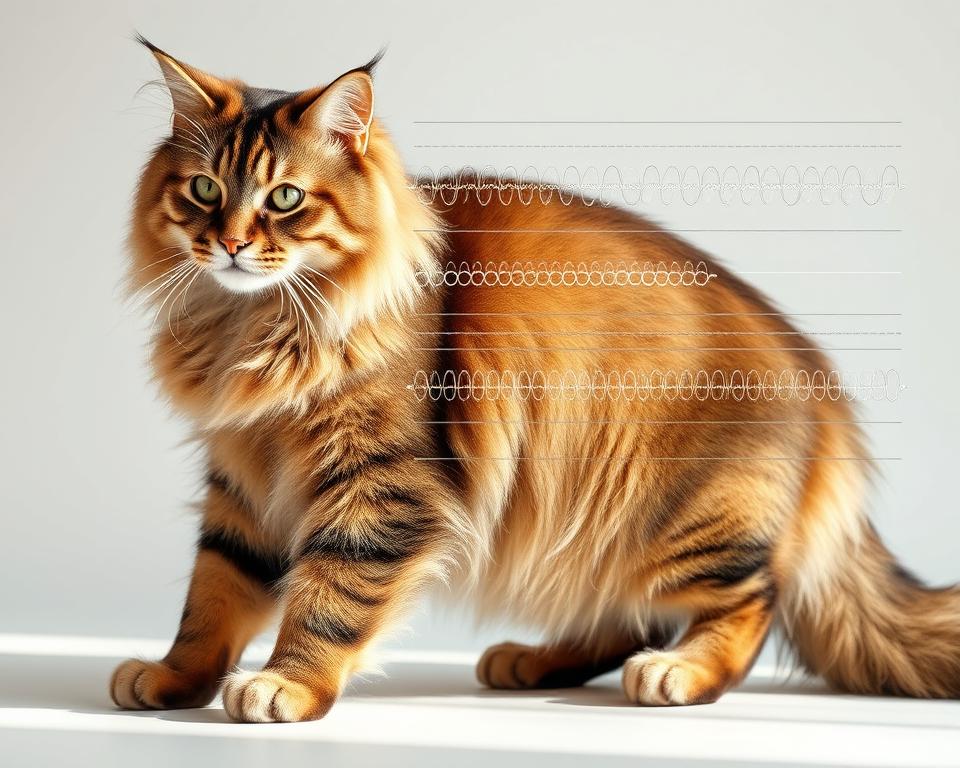
| Trait | Genetically Influenced | Enhanced by Selective Breeding |
|---|---|---|
| Body Size | Yes | Yes |
| Fur Density | Yes | Yes |
| Muscle Mass | Yes | Yes |
| Tail Length | Yes | Occasionally |
In short, the science behind Maine Coons’ size is both interesting and complex. It mixes natural genes with human breeding. Together, they keep the breed’s special traits alive.
Why are maine coon cats so big
Maine Coon cats are known for their Maine Coon breed characteristics. They have a muscular build and are among the large felines in domestic cats. Their size and health come from genetics, history, and environment. This makes them big, agile, and strong.
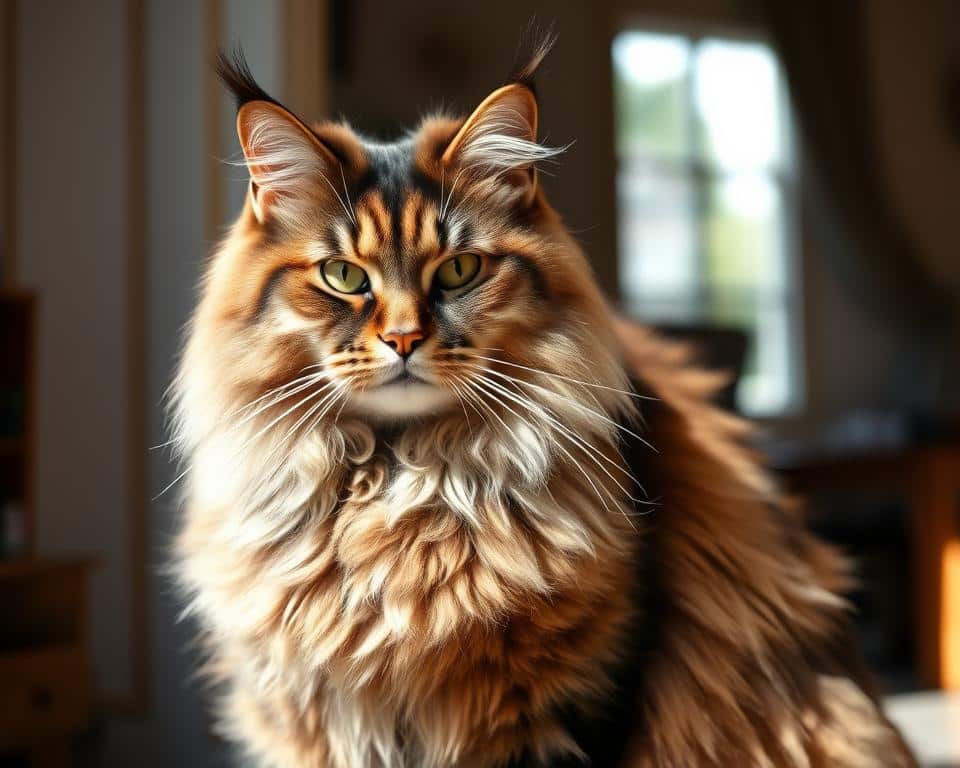
Their size comes from genetics and breeding for survival and hunting. Early American settlers valued them for hunting and their thick fur. This fur kept them warm in cold weather. Over time, they became the large, muscular cats we know today.
| Feature | Description |
|---|---|
| Size | Large body size with long legs and a broad chest. |
| Build | Muscular and powerful, well-suited for physical activities. |
| Fur | Thick, dense fur that provides insulation. |
| Tail | Long, bushy tail used for balance and warmth. |
Maine Coon breed characteristics make them look iconic and adaptable. Their muscular build makes them great hunters and pets worldwide.
Physical Traits Contributing to Their Stature
Maine Coons are known for their impressive size. It’s not just their genes that make them big. Their muscular build and solid body shape play a big role too. These cats are a mix of strength and agility, making them stand out.
Their broad chest and wide-set limbs are key. They support the cat’s weight well. This strength is crucial for their daily activities, like stretching and climbing.
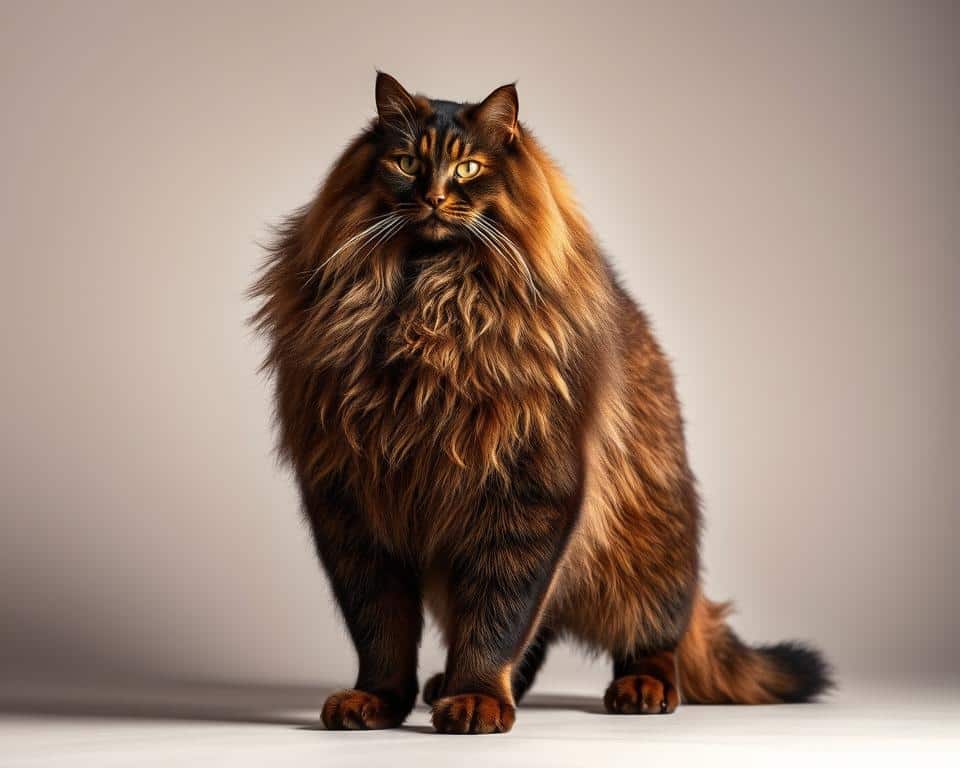
Maine Coon paws are special, looking like snow shoes. They help the cat move easily on snow. This shows how well the breed has adapted to different environments.
Their long, bushy tails are not just for looks. They help the cat balance and keep warm. The tails’ length and fluffiness make the Maine Coon look even more majestic.
Impact of Diet and Nutrition on Growth
Maine Coon cats grow well until they are three to five years old. Their diet and nutrition play a big role in this. Giving them the right nutrients is crucial for reaching their full size.
Kitten nutrition is especially important for these big cats. Their long kittenhood needs constant food support for muscle growth and development. Their diet should have lots of high-quality proteins to help them grow.
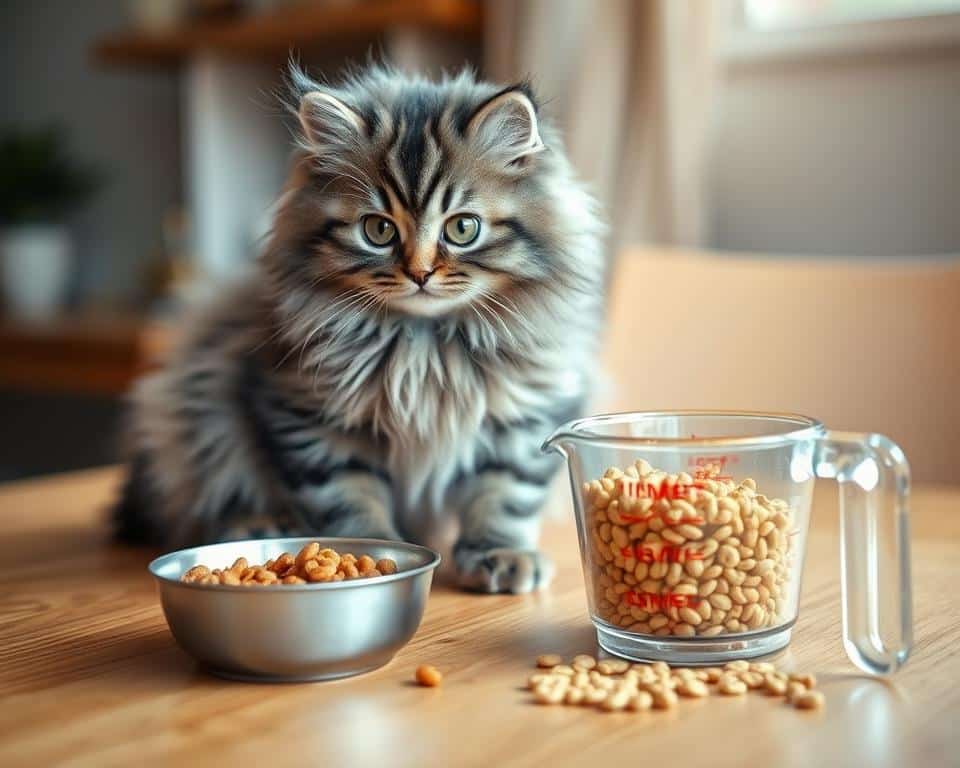
The table below shows what nutrients Maine Coon kittens need compared to regular kittens. This diet supports their bigger size and meets their specific needs for healthy growth.
| Nutrient | Regular Kitten (% of diet) | Maine Coon Kitten (% of diet) |
|---|---|---|
| Protein | 30% | 35% |
| Fat | 20% | 22% |
| Calcium | 1.2% | 1.4% |
| Fiber | 1.5% | 2.0% |
| Omega-3 Fatty Acids | 0.3% | 0.5% |
This special diet helps keep them healthy during their growing years. It sets them up for a life full of energy and health. Food made just for Maine Coon kittens usually has these special nutrients.
Knowing about Maine Coon growth and kitten nutrition is key. It’s not just good—it’s necessary for raising a healthy, lively Maine Coon cat.
Historical Hunters: Survival of the Fittest
Maine Coon cats are known for their size and strength. They have a long history of survival. Their hunting adaptations and cold weather survival skills helped them thrive in harsh climates. This section looks at how their physical traits gave them an edge in the wild.
Adaptations for Hunting in Cold Climates
Maine Coons evolved to survive and hunt in cold weather. Their thick, water-repellent fur keeps them warm and dry. This allows them to hunt well, no matter the weather.
Their ears and paws are also special. They help the Maine Coon detect prey in the snow. This is a key large cat advantage.
Benefits of Being Large and Muscular
Maine Coons are not just big and strong; it’s crucial for survival. Their muscular bodies help them catch prey, from small rodents to larger animals. This kept them at the top of the food chain.
Their size also scared off predators. This shows the benefits of their large physiques.
Maine Coons have a rich history as hunters. Their ability to adapt and thrive is a testament to their resilience. This makes them a beloved breed.
| Feature | Survival Benefit |
|---|---|
| Dense Fur Coat | Insulation and protection against cold, wet conditions |
| Large Size | Enhanced strength for hunting larger prey and warding off predators |
| Powerful Muscles | Superior agility and power, crucial for chasing and capturing prey |
| Broad Paws | Act like natural snowshoes, aiding in stability and mobility in deep snow |
Caring for a Giant: Health and Well-being of Maine Coons
Maintaining the health of Maine Coons requires regular vet visits and exercise. These big cats need preventive care and physical activity. This keeps their size from affecting their health.
Importance of Regular Veterinary Check-ups
Regular Maine Coon health check-ups and vet visits are key. They help catch health problems early, like HCM and PKD. Early treatment can extend their life and improve their quality of life.
Setting up a vet visit schedule is important. It helps keep their health in check and ensures they stay at a healthy weight.
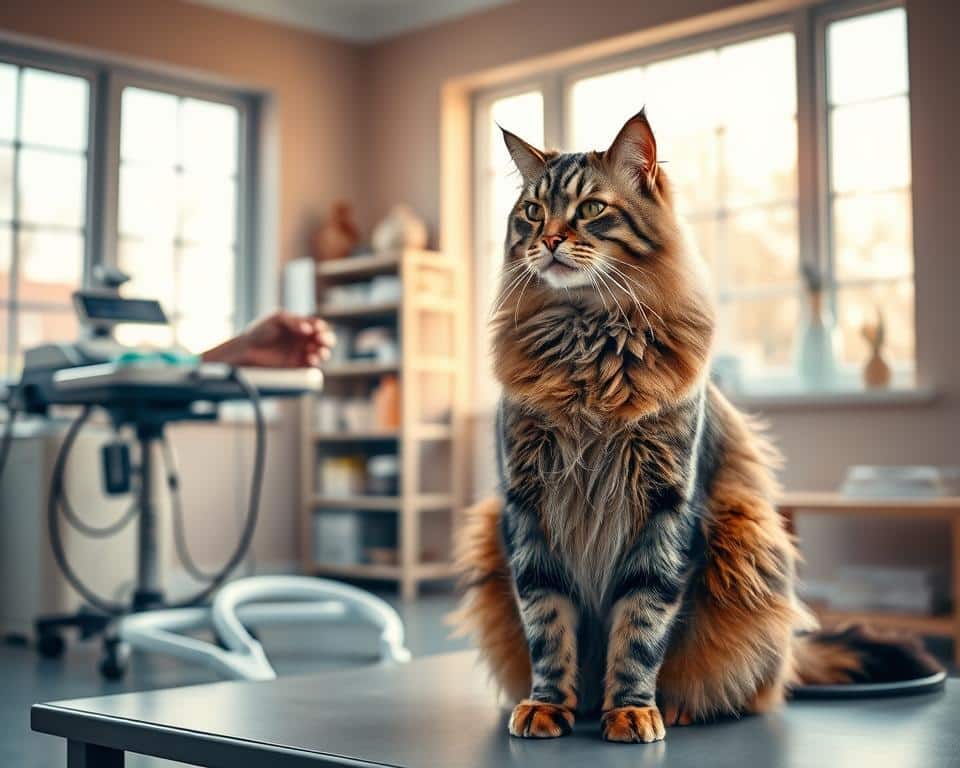
Exercising Your Maine Coon
Maine Coon exercise is crucial for several reasons. It helps manage their weight and keeps them active. Activities that mimic hunting, like chasing, keep them engaged and fit.
Interactive toys and playtime are essential. They help maintain muscle strength and agility. This ensures your Maine Coon stays healthy and happy.
By focusing on health check-ups, weight management, and exercise, you can keep your Maine Coon healthy. This approach ensures they live a long, happy life, bringing joy and companionship to your home.
The Role of Environment and Lifestyle
The Maine Coon lifestyle greatly affects their health and looks. This makes the choice between indoor vs outdoor cats very important for this breed. Knowing how their environment shapes their activities and behaviors helps us understand what’s best for them.
Indoor Maine Coons need lots of playtime from their owners to stay fit. Without enough exercise, they might get too fat. On the other hand, outdoor cats get to climb, hunt, and explore. This keeps them physically fit and lowers stress.
| Living Environment | Activity Type | Benefits |
|---|---|---|
| Indoor | Structured play, interactive toys | Safe from outdoor hazards, controlled diet |
| Outdoor | Natural exploring, climbing | Enhanced physical fitness, stimulation |
Whether they’re indoor vs outdoor cats, Maine Coons do well with a balanced lifestyle. They need enough room and fun to stay healthy and happy.
Exploring Myths and Legends
The Maine Coon is full of mystery and stories. These tales, filled with Viking cats and royal adventures, add to the breed’s rich history. But they also mix fact and fiction.
Tales of Viking Ship Cats and Royalty
One of the most charming Maine Coon myths is their connection to Viking ships. Their strong bodies and thick fur coats led people to believe they came from Norwegian Forest cats. These cats sailed with the Vikings.
Another legend links Maine Coons to Marie Antoinette. It says she put her Turkish Angora or Siberian cats on a ship to America. Though she didn’t make it, her cats might have, starting the Maine Coon breed.
The Truth Behind the Size Myths
Genetic studies have shed light on the Maine Coon’s true origins. They show Maine Coons come from Western European cats, not raccoons or bobcats. Their size and looks are due to adapting to the cold American Northeast, not myths.
The idea that Maine Coons come from raccoons or bobcats is a popular myth. But science proves it’s not true. The Maine Coon size myths are based on stories, not facts. They show these cats are the result of natural selection and breeding for their environment.
| Myth | Reality |
|---|---|
| Viking cats descendants | Related to Western European felines, adapted to Northeastern America |
| Descendants of Marie Antoinette’s cats | No historical evidence, breed development attributed to local breeding |
| Part raccoon or bobcat | Genetically related to Western European domestic cats |
Conclusion
The Maine Coon breed has captured hearts worldwide. We’ve looked into why these cats are so big. Their size comes from history, genetics, diet, and more. It’s not just luck.
These cats are not just big; they’re also tough and friendly. They can handle cold weather and are great hunters. This makes them special.
For those who love Maine Coons, knowing about their needs is key. They need good food, health care, and a loving home. This helps them grow strong and happy.
By caring for Maine Coons, we connect with them on a deeper level. They become more than pets; they become part of the family. Their size, personality, and love make them unforgettable.
Our love for Maine Coons will only grow as we learn more about them. They bring joy and love into our homes. They are truly special.

